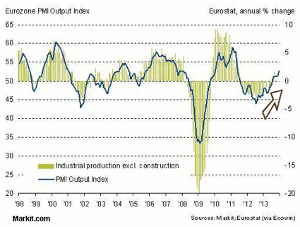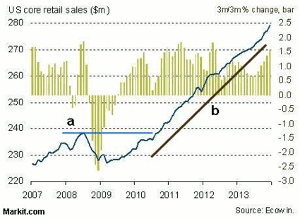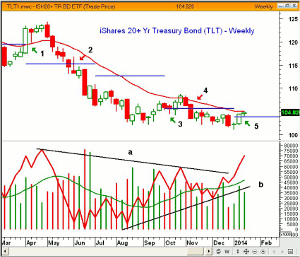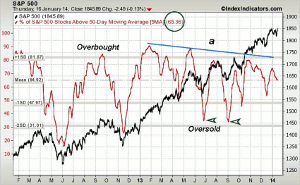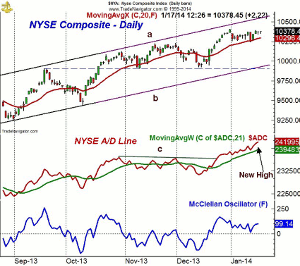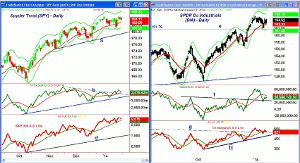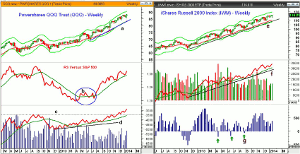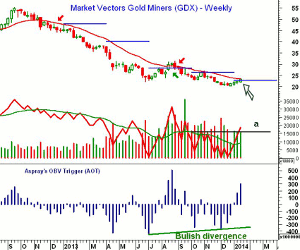Although the aging bull market has some investors turning more cautious, there are still a lot more bulls than bears around, and MoneyShow's Tom Aspray believes this dynamic needs to change in order to fuel the market's next leg up.
Last Monday's loss of more than 1% in the S&P 500 and the 2014 new daily closing low got the market's attention but the bulls quickly took over as stocks closed the week well above the worst levels.
The financial media continues to parade a host of bullish analysts ignoring that a few had been predicting horrible crashes over the past six months. The individual investor has become a bit more cautious as according to AAII, just 38.9% are now bullish as opposed to 55% the day after Christmas. It would appear that most have moved to the correction camp as the number of bears is still low at 21.5%.
Though this reading makes a correction less likely over the short term, it is still too high. At last August's lows, when the Spyder Trust (SPY) was at $163, only 29% bullish. Friday's weaker than expected Consumer Sentiment reading from the University of Michigan may help to dampen some investor bullishness.
The poor monthly jobs report was quickly discounted by most economists but if we get another weak jobs report in February, it would be harder to ignore. Friday's Housing Starts showed a decline of 9.8% in December but it will probably take several disappointing economic reports to dampen the high level of bullishness.
One of the more surprising developments of the past month or so has been the strong performance by some of the European country ETFs. Leading the pack is Spain as the iShares MSCI Spain (EWP) is up about 10% since the December 18 taper lows but did give up some ground last week.
This is quite a bit better than the 9.2% gain of the iShares MSCI Italy (EWI) or the 8.9% rise in the iShares MSCI Austria (EWO). All three have done significantly better than the Spyder Trust (SPY), which is up 3.6%. The French and German country ETFs have not yet moved above their late 2013 highs.
As I have been reporting since November, there has been continued improvement in the economic data from the Eurozone. Manufacturing is an important part of these developed economies and the chart of the Eurozone Purchasing Mangers Output Index shows that it has moved sharply into positive territory.
From a historical perspective, changes in this trend are rarely reversed, suggesting that these economies will improve further in 2014. According to Markit their Eurozone PMI hit a 2-1/2-year high last month, with Spain's PMI showing the sharpest increase. On Thursday, we get new data for both the US and Eurozone.
Last Tuesday's Retail Sales data was also a pleasant surprise as it was stronger than expected in December. This points to a strong 4th quarter GDP reading, and the chart shows a strong uptrend (line b) since the 2008 highs, line a, were overcome.
NEXT PAGE: What to Watch
|pagebreak|With Monday's Martin Luther King holiday, we have a shortened trading week and investors will need to wait until Thursday for the next round of economic data.
In addition to the jobless claims on Thursday, we get the PMI Manufacturing Index, Existing Home Sales, and Leading Indicators. In last week's column, I focused on the LEI and provided a long-term chart.
The bond market is typically focused on the economic data and the technical improvement in the iShares 20+ Year Treasury Bond ETF (TLT) in 2014, is hinting of lower long-term rates. On the chart, I have drawn the quarterly pivot levels, which were featured in Friday's column.
The green and red arrows note the several times over the past year when TLT had a weekly close above or below its quarterly pivot. For example, in the 1st quarter, TLT stayed below the pivot but opened the second quarter above its pivot (point 1).
The rally in TLT peaked in early May, and at the end of the month, it closed back below its pivot (point 2). This coincided with the completion of the reverse head-and-shoulders bottom formation in the 10-year T-note yields, which also signaled that rates were moving higher.
After the first week of trading in 2014, TLT closed back above its pivot, line 5. The breakout in the OBV above its resistance at line a is also a positive technical sign for TLT. The OBV has been forming higher lows, line b, since the August lows.
The ETFs that track shorter-term yields do not show the same bottom formations and TLT has strong resistance at $108.74. It is possible that the rise in TLT is warning that we may see further weak economic reports in the weeks ahead but if it triggers a deeper market correction, it should be a better buying opportunity.
What to Watch
Those who focus on the fact that the S&P 500 is pretty much at the same level it was at the close of 2013 are missing the big picture as there has been plenty of movement amongst the sectors. The Semiconductor Holders (SMH) is up almost 1% already in 2014 while the Sector Select Energy (XLE) is down 2.7%. Even worse is the S&P Retail Index, which is down over 5%.
The action was choppy last week but there are other industry groups, like the homebuilders, that need only a couple of strong consecutive closes to complete their corrective patterns. We are in the thick of earnings and the market has not been forgiving as it is punishing some stocks that reported better than expected earnings.
Even though the market dropped in late trading, there was some improvement in the technical market outlook last week. This suggests that the major averages could still push to new highs after the current period of consolidation is completed.
The majority of market-tracking and sector ETFs that I follow are positive as they are trading well above their quarterly pivots. A full table was published Friday (1st Quarter ETF Levels to Watch), and it would take a weekly close below their quarterly pivots to weaken their outlook. The pivot resistance levels from the table can be used for upside targets.
Even though I think the short-term outlook has improved, one has to be a very selective buyer as there are some individual stocks that have too high a risk at current levels. The five-day moving average of the S&P 500 stocks above their 50-day MAs is at 65.36%, which is quite close to the mean at 64.92%.
This is a pretty neutral reading and does allow for a move back to the previous peak around 75%. The % shows a pattern of lower highs (line a) with the downtrend now above 80%. In June and August, the % dropped to the 35% area (see arrows), which set up good buying opportunities. I would wait for similar levels to be reached before becoming a more aggressive buyer.
NEXT PAGE: Stocks
|pagebreak|The daily chart of the NYSE Composite shows that it dropped down to test its 20-day EMA last Monday, and it is providing short-term support now at 10,294. The quarterly pivot is at 10,082, which also correspond to the monthly projected pivot support.
Once above the late 2013 high of 10,406, the upper boundary of the trading channel, line a, is at 10.545. The weekly starc+ band is at 10.628.
The new highs in the weekly NYSE Advance/Decline at the end of 2013 have been confirmed by new short-term highs last week in the daily A/D line. It had broken through resistance, line c, in December. The sharp increase indicates that any pullback over the short term should be followed by a further rally.
The McClellan oscillator came close to the zero line last Monday but has bounced back to the +99 level. It is still well below the high of +170 that was hit in December.
S&P 500
The Spyder Trust (SPY) closed below its 20-day EMA last Monday as it reached a low of $181.34 and came fairly close to its daily starc- band. This also corresponds to the support from the late November and early December highs. There is still more important support at $179-$180 (line a) with the quarterly pivot at $177.97.
On a strong close above the $185 level, the daily starc+ band is now at $186.33 with the weekly at $188.96. The recent trading range has targets in the $189.50-$190 area.
The daily on-balance volume (OBV) has improved as it was finally able to move above its negative divergence resistance at line b. It has still not been able to move above the November highs but is holding above its rising WMA. The weekly OBV has made new highs.
The daily S&P 500 A/D line did confirm the new highs as it moved well above the resistance from November. It is holding up quite well as it is still above its rising WMA.
Dow Industrials
The SPDR Dow Industrials (DIA) dropped back to the late November lows as it hit a low of $162.14 on Monday, which was just below the monthly pivot at $162.68. It rebounded the next day to close at $163.45. It has been consolidating above its 20-day EMA ($163.33) for the past few days.
There is resistance now at $165.29-$165.51 with the daily starc+ band at $166.13. The monthly projected pivot resistance for January is at $171.12.
The daily OBV dropped back to test the breakout level, line f, last week but is now trying to turn higher. It is still below its WMA but the weekly is just turning up from its rising WMA.
The Dow Industrials A/D line moved above and below its WMA several times last week but did overcome the stronger resistance, now support (line h), in late 2013. There is more important A/D line support at line h.
Nasdaq-100
The PowerShares QQQ Trust (QQQ) is ready to make a new closing high as it dropped below the prior week’s low, hitting $85.68 before rebounding. It has been holding well above the weekly support and the 20-week EMA at $83.53. The quarterly pivot is at $84.08.
The weekly starc+ band is at $90.63 with the quarterly R1 resistance at $91.83.
The weekly relative performance dropped back to its rising WMA at the start of January and has turned up sharply. It formed a classic bottom in the late spring and summer (circle b). It continues to indicate that it is a market-leading ETF.
The weekly on-balance volume (OBV) made significant new highs as it broke through major resistance at line c. The WMA is rising strongly and it was last tested in August.
The daily Nasdaq 100 A/D line (not shown) has not yet moved above the late December high as it dropped below its rising WMA last week. It is still positive and not far from making a new all-time high.
Russell 2000
The iShares Russell 2000 Index (IWM) has also been acting well, so far in 2014, and is also ready to close above the late 2013 high this week. The weekly starc+ band is at $119.38 with the monthly projected pivot resistance at $120.20.
The low last week slightly violated the monthly pivot at $113.55 but did not close below it. The quarterly pivot is at $111.44.
The weekly OBV made new highs last week and continues to lead prices higher. The Aspray OBV Trigger (AOT) flashed a buy signal last August (point g) as the OBV dropped below its WMA for one week. Additional signals (see arrows) occurred at the April and June lows.
The daily Russell 2000 A/D line (not shown) made another new high last week but closed the week just above its WMA
NEXT PAGE: Sector Focus, Commodities, and Tom's Outlook
|pagebreak|Sector Focus
The iShares Dow Jones Transportation (IYT) closed the week a bit lower, but that was not surprising after the prior week’s strong close. The monthly projected pivot resistance is at $136.15, with the weekly starc+ band at $137.94.
This still looks like a market leading sector and I continue to look for stocks in its industry groups that look positive technically.
As for the ETF performance, I am still looking at how they are doing so far in 2014, as the only index tracking ETF that is positive is the iShares Russell 2000 Index (IWM), up 0.5% for the year. The Select SPDR Health Care (XLV) is leading the market higher, up 2.9%.
As I noted last week, there are quite a few of the big health care names that have earnings this coming week and it will be interesting to see if XLV can maintain its upside momentum.
The Select SPDR Financials (XLF) and Select SPDR Utilities (XLU) are positive for the year, as is the Select SPDR Technology (XLK).
The sharp drops in many of the retail stocks has hit the Select SPDR Consumer Discretionary (XLY) hard, as it is down 2.8%, while the Select SPDR Energy (XLE) is worse, down 2.8%.
I have also added the SPDR Gold Trust (GLD) and the Market Vectors Gold Miners (GDX) to the table and GDX is up over 10% in 2014.
Crude Oil
The March crude oil contract held above the prior week’s lows and did close higher for the week. It will take further gains on heavier volume to signal that a bottom is in place. There is strong resistance now in the $96.76-$97.50 area.
Precious Metals
The SPDR Gold Trust (GLD) did close slightly higher for the week, but the Market Vectors Gold Miners (GDX) looks much better technically.
GDX did close last week well above its quarterly pivot at $22.76, and the OBV has moved above its previous swing high, line a, consistent with the completion of a bottom.
The AOT turned positive three weeks ago and was very strong last week. I will be looking for an entry in GDX on the next short-term pullback.
The Week Ahead
So far, the action in January is starting to frustrate the bulls, which is a good sign. Nothing goes straight up or down. The consolidation pattern of the past few weeks may result in more selling over the short-term, especially with Friday’s mixed close.
The recent new long positions are generally holding up well, but I will continue to follow a selective buying strategy until the market becomes more oversold and the bullish sentiment is not so high. There will be some selective stocks to buy, as quite a few logged some impressive gains last week, despite the lackluster action in the major indices.
The strategy I outlined for 2014 last week “A Path to Investing Success in 2014” should continue to give you some good guidelines, especially for new investors.
Don't forget to read Tom's latest Trading Lesson, Volume Always Precedes Price.


